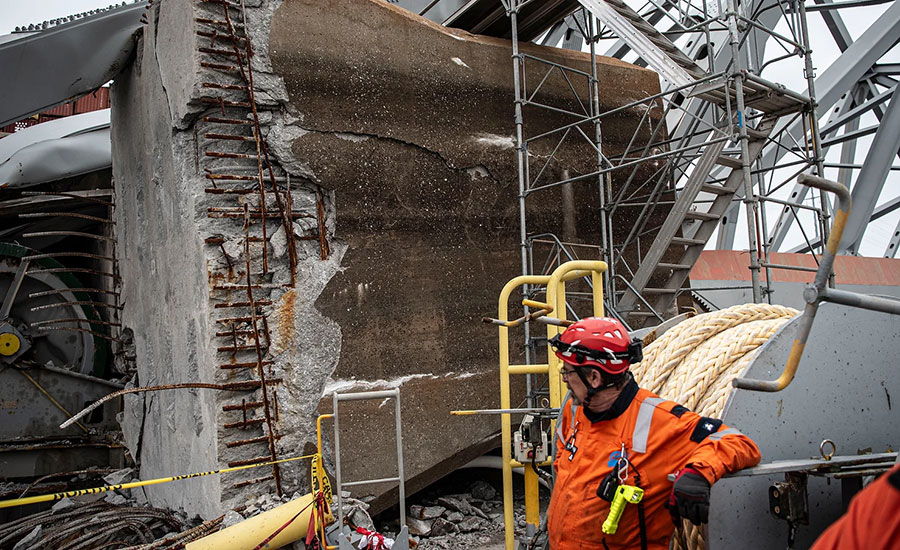Note: The text of this article has been updated 5/7/24 to reflect new information.
Plans for rebuilding the Francis Scott Key in Baltimore are taking shape as salvage teams prepare for next major milestone of the March 26 collapse clean-up effort—removal of an approximately 5,000-ton section of steel and concrete from the bow of the grounded container vessel M/V Dali.
The Maryland Transportation Authority says it will issue a progressive design-build request for proposals by the end of May for a new cable-stayed structure, with a goal of having the new crossing open as early as Fall 2028. Agency officials note that the preliminary estimated construction cost of between $1.7 billion and $1.9 billion is in line with projects of similar scale and complexity, citing the $1.6-billion Gerald Desmond Bridge Replacement at the Port of Long Beach, Calif. (since renamed the Long Beach International Gateway), completed in 2020, and the $1.5-billion Goethals Bridge Replacement Project in New York, completed in 2018.
MDTA has scheduled an industry forum for May 7 to share details of the progressive design-build procurement with the construction and engineering community.
Funding for the replacement bridge will come from federal sources, insurance proceeds and other reimbursements, according to MDTA. That includes a $350-million payment from the state’s insurance policy on the bridge reported last week. Maryland also is pursuing other recovery options to minimize net cost to taxpayers and toll customers, MDTA says.
Several design firms have already released conceptual renders of possible replacement bridges, signaling their intent to pursue the project.
Italy’s Webuild group, which includes U.S. subsidiary Lane Construction, has already announced its intention to vie for the project, having provided Maryland transportation officials with a pro bono preliminary proposal for a cable-stayed structure, and citing its experience leading the fast-tracked reconstruction of the collapsed Genoa Bridge.
In the weeks since the Dali collided with the original 50-year-old through-truss bridge after an apparent power loss, Maryland officials led by Gov. Wes Moore (D) have lobbied members of Congress to build bipartisan support for fulfilling President Joe Biden’s pledge of full federal funding for a replacement structure. Last week, a congressional delegation surveyed the wreckage and received a briefing on salvage efforts from the multi-agency unified command overseeing response operations.
 Efforts to remove the debris from the ship have proven more complex than initally thought.
Efforts to remove the debris from the ship have proven more complex than initally thought.Photo courtesy Unified Command
The strategy for refloating the Dali, which the unified command expects will take place by May 10, has been in development since the incident occurred in order to thoroughly evaluate and address the complexities of handling roadbed material, crushed containers and bridge fragments resting across the vessel’s bow. Gov. Moore told a recent press briefing that one side of the section is the size of the 984-ft-tall Eiffel Tower, while the other is leaning against the riverbed of the 50-ft-deep channel.
The meticulous operation has combined precision cutting techniques with the support of massive specialized equipment such as Donjon Marine’s Chesapeake 1000 sheerleg crane, and a 1,000-metric-ton hydraulic wreck grab, nicknamed “Gus.” The Dali’s hull was apparently not breached in the collapse, unified command says, and inspections have found no signs of leaking. More than 180 shipping containers have been removed from the vessel to facilitate removal of the bridge section.
“The complexities of this next phase of operations require thorough preparation, strategic planning, and specialized expertise,” U.S. Coast Guard Capt. David O’Connell, unified command’s federal on-scene coordinator, said in a statement. “We have the right team making this work happen in the safest and most efficient way possible.”
Salvage divers continue to be constrained by jagged wreckage and limited visibility underwater, conditions that also hampered the search for the remains of a missing construction workers who was part of a crew performing concrete deck repairs when the Dali collided with the bridge. Maryland State Police recovered the body of a fifth victim from a submerged construction vehicle on May 1, and announced May 7 that they had recovered the remains of the sixth and final victim. Two members of the eight-person crew survived the collapse.




